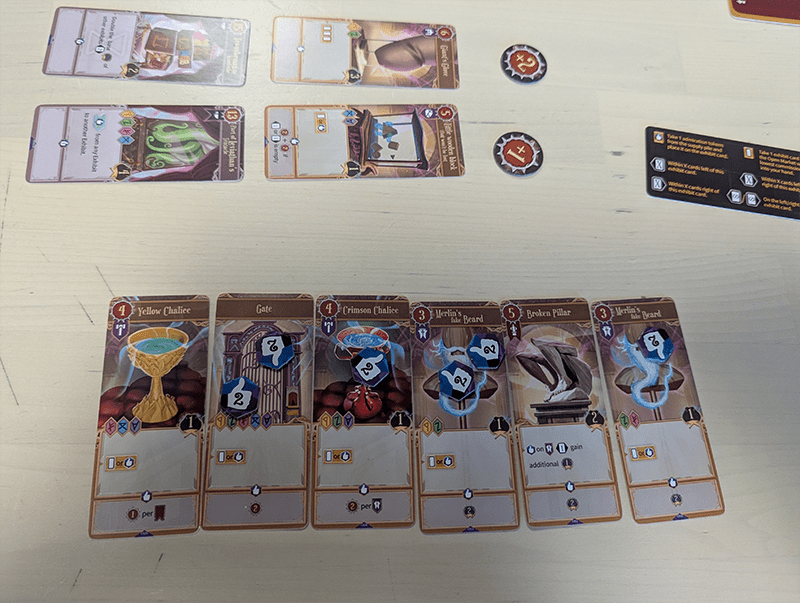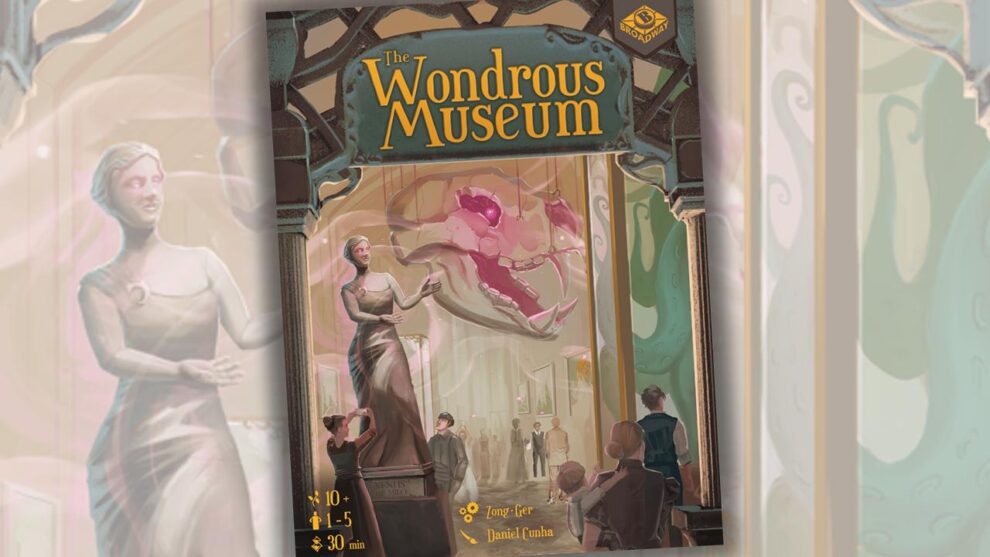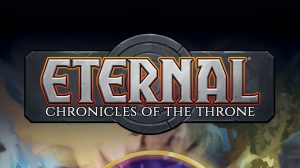Disclosure: Meeple Mountain received a free copy of this product in exchange for an honest, unbiased review. This review is not intended to be an endorsement.
After nearly half a dozen reviews, I finally did it.
I am reviewing an original game.
Not a remaster. Not a reprint.
Something new. Something fresh. The Wondrous Museum promises a 30-minute play where you place magical exhibits, trigger cascading effects, and chase applause like it is currency. Scratch that, applause is currency in this game, and it’s how you get new cards. The theme is charming, with strange pieces like Merlin’s fake beard on display, but beneath the curtain is an efficiency puzzle built on timing and momentum.
You and your friends are curators at this strange little museum, locked in a friendly competition to see who does the job best. Everyone starts with a gate card, then slowly builds a row of magical exhibits, adding to the front or back. When you activate, the row triggers from left to right, setting off effects in sequence. If that sounds like Wingspan, it should. Imagine Wingspan with just one row, and you get the general idea of what The Wondrous Museum is about.

The Museum Blueprint
Each exhibit card has a cost, an ability, and a point value, as one would expect in a standard engine-builder game. What sets The Wondrous Museum apart is the use of appreciation tokens. These are earned through card effects and placed directly on exhibit cards themselves, where they boost their value. Some cards convert tokens into cash, others into points. The trick is placing them wisely, then getting exhibit cards that let you shift tokens around to where they’ll matter most.
Like most games in this genre, there’s an open market of exhibit cards to buy from. It refreshes at the end of each turn if a card is taken. On top of that, each game includes five Black Market exhibits. These are unique, expensive, and limited to one per player. They don’t mess around and are not refilled. If you want a real shot at winning, you’ll need one.
That’s the general overview. Curators building displays, chasing applause, and sneaking in the Black Market exhibits when no one’s looking. It sounds good on paper, but a museum is only as impressive as the way it runs. So, how does the whole thing actually work?
Running the Show
On your turn, you have one of three actions to take: Buy an exhibit card, exchange, or open the museum.
Buying an exhibit means taking a card from the open market, the Black Market, or your own hand. You pay using appreciation tokens on exhibits that generate money, or by discarding cards from your hand for one coin each. Once paid for, the card is placed at the front or back of your row. Simple enough.
Exchange is the action you take when you need more options. Draw three cards from the top of the exhibit deck, keep them all, then discard one from your hand. That’s it.
The most “complicated” action is opening the museum. This is where effects trigger and where the core of the game actually kicks in. You have five colored stones, and activating your museum means spending one of them. Each exhibit can only trigger with certain colors, so it’s not just about where you place your cards, but how the colors work together. That extra layer adds more depth than you’d expect.
Once a color is spent, it’s locked until your fourth stone activation. At that point, all colors reset and the last card in the open market is discarded. You’re not only managing exhibit placement and color synergy, but also the sequence in which you activate them. It’s a series of small decisions that add up quickly.
The game ends when one player has ten cards in their row, including the starting Gate, or when someone collects 20 points worth of appreciation tokens. Once that happens, everyone gets one final turn. After that, it’s over. Most points wins. Simple. Clean.

Fast, Lean, and a Little Broken
I’ll be honest here; I didn’t go in expecting much. Unknown designer, small box, and a rulebook that checked all the usual engine-builder boxes. But let’s just say my first impressions didn’t make it out alive after the first session and it’s probably in the bottom of a river right now. There’s a lot to like here.
For starters, the game moves. Turns are fast, the actions are simple, and the rules are easy enough to teach in under ten minutes. You’re either buying a card, activating your row, or drawing new options. That’s it. The pacing is so fast I half expected someone to show up with a clipboard and ask for a urine sample.
It also packs a decent amount of replayability. Each game starts by mixing two exhibit sets into the main deck, and each set comes with its own twist. Some focus on adjacency, others let you mess with your opponents’ appreciation tokens, improve how those tokens work, or even bend the rules around colored stones. It keeps things fresh without bloating the game.
With such a short runtime, the game rushes you along like it’s late for a doctor’s appointment. The Wondrous Museum isn’t interested in clean, linear combos. It wants you to find the cracks in the system and exploit them as soon as possible. There’s a real joy in discovering broken synergies and pushing them as far as they’ll go. It actually reminds me of Res Arcana, but simpler, more approachable, and definitely less balanced.
Look, I’m not going to pretend I’m some pro-level Wondrous Museum player, but I’ve been in the trenches of engine-builders longer than I care to admit. I know the genre, and over time you start picking up patterns that carry across games. One of the big ones is cost versus payoff, as in how much you pay for something versus how many points it can produce. To keep it simple, a few Black Market cards and some exhibit cards feel underpriced for what they give you. They’re not instant wins, but ignoring them puts you at a disadvantage.
Final Exhibit
I also have to point out that the graphic design could use some work. A few icons are not as intuitive as they should be, especially the one for moving appreciation tokens. It often ends up being the biggest stumbling block for new players. Thankfully, the game includes a player aid, which softens the blow a little bit.
The Wondrous Museum is not going to shake up the genre, but it knows exactly what kind of game it wants to be. It’s quick, clever, and just messy enough to keep you coming back for one more round. For a small-box title from a designer I had never heard of, it left a solid impression. And if nothing else, it taught me one thing: never underestimate a game that looks like it belongs in a gift shop. Sometimes, that’s where the good stuff is hiding.











